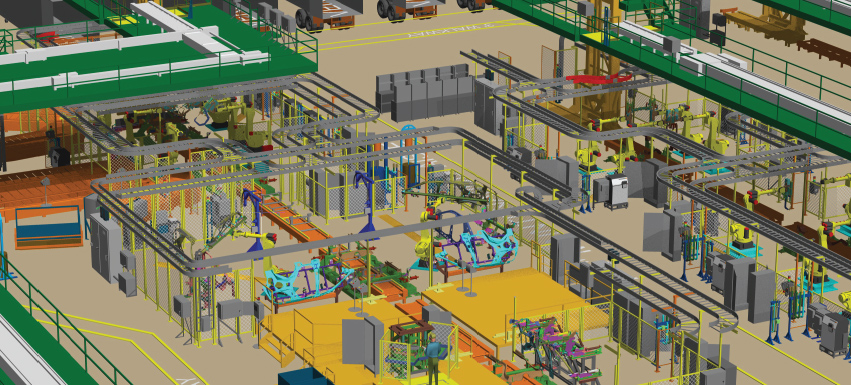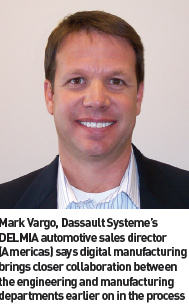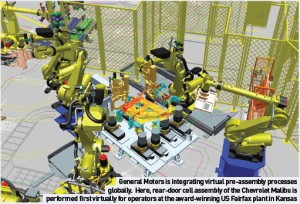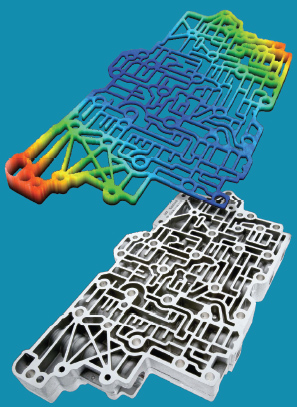
Digital manufacturing is only now coming in to its own, and carmakers are using the virtual factory to assist in reducing time to market of products.But this technology can save them a lot of money as well
This year, thousands of Saturn Outlooks, GMC Acadias and Buick Enclaves will glide off the assembly line at Lansing Delta Assembly Centre, a new high-tech General Motors plant in Lansing, Michigan. Last year’s first production run of 6,729 vehicles, based on two models and only part of the year, is expected to increase rapidly. What is so significant about that, coming from a mass producer like GM?
These were the first GM vehicles built from 100 per cent virtual design and production templates. Each vehicle holds out high hopes for both product innovation and quality at the carmaker. Indeed, the Acadia is the first GMC vehicle built on something other than a traditional truck frame. Outlook started production last November, and Enclave began in April 2007.
GM executives in product engineering-design, IT and manufacturing believe that adopting digital will be a clear-cut differentiator in both product quality and future competitiveness. That’s important as the company struggles to stem the tide of financial losses and a decline in market share that have plagued the carmaker for the past two years.
Joe Kaczmarek, GM’s Director of Manufacturing Technology, who has been with the company for 28 years says: “We share actual designs, processes and work tools globally. The pipeline has moved past vehicle design into manufacturing engineering and plants themselves. We use the digital pipeline to tie us all together.” What GM has done is tear down ancient silos of communication and restructured its design, IT engineering and production processes using digital software tools – and even the factories that build them. The digital phase has taken at least 12 years to perfect.
 Even with functional improvements and greater availability, the fact remains that the $525-million digital manufacturing industry is underused, if anything. Consultants point out DM is still in its infancy and will expand as more decision-makers get up to speed. Others say resistance is not a skills issue, but sensitivities to job protection and knowledge sharing.
Even with functional improvements and greater availability, the fact remains that the $525-million digital manufacturing industry is underused, if anything. Consultants point out DM is still in its infancy and will expand as more decision-makers get up to speed. Others say resistance is not a skills issue, but sensitivities to job protection and knowledge sharing.
“Is the technology under-used? Absolutely. It’s an education process. If you look at the departments that are investing in PLM-related processes and equipment purchasing, it is mostly in engineering,” observes Ed Miller, President of CIMdata. “It represents a change in culture and the way people work. It’s a real change, especially for middle managers. They don’t have as much experience with it. Support for it is just starting,” he says.
Rod Horrocks, analyst at British firm Procertis adds, “The resistance [to the technology] is mostly in relation to jobs (being displaced) rather than to techniques or skills themselves.” Another sticky wicket is that carmakers are still resolving the burden of legacy systems and trends that come and go like fashions. Horrocks says, “This leaves more legacy – and the crazy pace of technology throws in even more so-called solutions.” In some cases, manufacturers and stakeholders are sorting out silos of communication and responsibility. There may be a confl ict in how to best get the work done with existing software tools.
Mark Vargo, DELMIA’s US sales director observes, “The most important gap is the collaborative work between engineering and manufacturing early in the production process.” Computer-aided manufacturing (CAM), which has been around for about 20 years, is still an important part of PLM (product lifecycle management) implementation. It spans computer-aided design (CAD) and digital manufacturing, enabling companies to design production operations faster and more accurately than conventional processes. Dick Slansky, senior analyst at ARC Advisory Group sees the tide shifting. He projects the DM marketing/planning market will grow 15 per cent in the next four years. “PLM is one of the faster adoption rates and it trickles down to other companies,” he says.
Siemens PLM’s Alain Iung tells AMS, “We need to get the word out that digital manufacturing (and related software components) is a reality of business. Many companies are not fully aware of the value provided by DM applications, especially when it comes to implementing DM as part of a PLM initiative. It’s capable of 30- to 40 per cent percent return on investment.”

Processes are digitally unified
The Lansing Delta plant for example, uses digital tools to validate before start of regular production. “We work closely with the business process department and make it (digital) part of our culture and DNA. It’s transforming how we do our work, and it’s a global transformation. I think we’re leaders in moving this out,” Kaczmarek says. Previously, the three groups worked separately with scant communication, a throw-it-over- the-wall approach. Now, cross-functional teams work collaboratively in the design and build stages. Operations such as welding, stamping, dies and paint shops are all digitally unified. The three production and IT heads now talk daily.
Bob Klem, GM’s Global Director – Information Systems Services, says that the carmaker’s digital maths process started with engineering in earnest about 12 years ago and has moved only in the past five years to manufacturing engineering and designs in CAD. “The pipeline continues to build out,” he tells AMS. “From an IT perspective, the main components of that are pretty much in place. Our role is in developing an IT toolkit and PLM management process. The emphasis, or competitive advantage, is in the process and how we use it, not in IT,” Klem adds. “The emphasis is really on the tools. IT is simply an enabler.” Digital manufacturing is a $525 million industry based on 2006 base year data, according to the ARC Research Advisory Group. That’s about seven per cent of the overall $7.5 billon PLM and related digital MPM (manufacturing process management) sectors, says ARC senior analyst Dick Slansky.
 To be fair, other global carmakers have growing or mature digital processes too. This technology is growing in popularity in other industry sectors too, including aircraft manufacture, motorsports, ship-building and electronics. “The automotive and aerospace industries are prominent in driving digital manufacturing advancement, because they deal with highly complex products and an expensive manufacturing environment. There’s a major cost involved in assembly line and tooling development. To date, the high end of the vehicle market is primarily investing in it,” says Ed Miller, President of CIMdata. “German OEMs are keenly investing in digital manufacturing while the US has been aggressive in adopting this technology.” In Europe, most investment has come from high-end companies such as BMW, Daimler, VW and others. The return on investment for these companies has been significant, according to Miller.
To be fair, other global carmakers have growing or mature digital processes too. This technology is growing in popularity in other industry sectors too, including aircraft manufacture, motorsports, ship-building and electronics. “The automotive and aerospace industries are prominent in driving digital manufacturing advancement, because they deal with highly complex products and an expensive manufacturing environment. There’s a major cost involved in assembly line and tooling development. To date, the high end of the vehicle market is primarily investing in it,” says Ed Miller, President of CIMdata. “German OEMs are keenly investing in digital manufacturing while the US has been aggressive in adopting this technology.” In Europe, most investment has come from high-end companies such as BMW, Daimler, VW and others. The return on investment for these companies has been significant, according to Miller.
Work sharing from a global perspective
Mark Vargo, Dassault Systeme’s DELMIA Sales Director Automotive (Americas), says the rate of uptake from American and European manufacturers is different. “Europe adopted process planning tools early, while the US was all about robotics capability. Process planning capability actually speeded up more rapidly with VW, Audi, BMW and DaimlerChrysler,” Vargo says, “Europe evolved from process planning to 3D tools, while the Detroit Three reversed course, going from 3D to process planning.” Still, digital is not simply the flavour of the month at GM.
Company officials are adamant that they are totally dedicated to a digital strategy. “We’re not just trying it out to see if we like it. Without digital maths, we couldn’t develop the products we do today. We may work on a programm on one continent and build it on a second, and then third continent. We’re absolutely committed to this strategy,” says John Moll, GM’s Global Director of Vehicle Integration, Safety and Virtual Vehicle Development. “It’s been part of our journey since we started using it to reduce costs. We’ve noticed a tremendous difference – digital enables us to do work sharing from a global perspective,” he adds.
On the upside, GM posted record 2007 third quarter global sales of 2.38 million vehicles, up by four per cent. In North America, where sales declined six per cent from last year, the carmaker’s mid-car and mid-utility crossover segments saw sales gains on the strength of its virtually-built midutility crossovers – the GMC Acadia, Saturn Outlook and Buick Enclave; plus its mid-car segment models Saturn Aura, Pontiac G6 and Chevrolet Impala, according to a company report.

A DELMIA and Dassault Systemes study entitled ‘The Benefi ts of Digital Manufacturing’ prepared by research consultancy CIMdata a few years ago offers good news for digital users. Companies using DELMIA digital manufacturing solutions are either meeting or exceeding initial objectives and saving time and money.
The study tracked DELMIA customers in automotive, aerospace and shipbuilding industries in the United States, Europe and Asia. Organisations adopting digital manufacturing technologies can expect annual returns of fi ve to ten times their annual investment, according to the study. Production throughput can be increased by 15 per cent with overall production costs reduced 13 per cent.
Digital manufacturing technology also can reduce:
• Time to market by 30%
• Design changes by 65%
• Time spent in planning process by 40%
“It is clear that DELMIA technology is solid, and organisations are achieving substantial benefi ts and return on investment. Digital manufacturing is clearly a necessary core technology for those companies who want to establish a leadership position in the highly competitive worldwide manufacturing marketplace,” Ed Miller, President of CIMdata is quoted as saying.
Virtual assessment rooms
In GM’s virtual assessment rooms, assembly teams and leaders see a vehicle or component like, for example, a large engine block developed in virtual space. The model shows how it moves through the plant, how operators integrate it in the vehicle compartment and work space. The virtual rooms are part of GM’s digital pipeline in plants worldwide; used extensively with new product development or launches. “This is all done in maths models before the first engine block is made. The teams see the entire process needed to assemble a vehicle,” says Klem. Images are projected on a screen and operators can focus on how much room they have to tighten a bolt and other assembly steps for example. Full digital deployment gives GM time to focus on fine-tuning. “The first cars coming off the line are better than they’ve ever been,” Moll tells AMS. “It gives us a reduction in pre-production numbers or prototypes.” Choosing the right software partners has become as natural as breathing.
GM, for instance, pairs with Siemens PLM Software (formerly UGS and acquired in May 2007 by Siemens NX for CAD and production, and TeamCenter for PDM. Siemens PLM Software launched Tecnomatix 8 in June as a body-in-white planner to enhance competitiveness and flexibility for users.
Alain Iung, Vice President, Tecnomatix Portfolio Marketing, Siemens PLM Software says, “We work on digital manufacturing globally with automakers on critical customer needs. Ours is a completely open system. Because we’re totally open, we have the capability to work with the latest releases of all major software programs. The Tecnomatix V8 software tool helps planning, validating and optimising processes as manufacturers look for faster ways to produce parts and ship them.”
Ford’s virtual builds win plaudits
In June 2007, Ford was celebrating, despite a decline in North American sales. Its Ford Fusion, Mercury Milan and Lincoln MKZ mid-size sedans achieved the best quality awards of any first-year vehicles in the carmaker’s history, as rated by JD Power and Associates’ Initial Quality Consumer Survey. This performance was repeated in October, as Consumer Reports recommended the trio as top buys in its annual survey of five million consumers. The survey assesses reliability, performance, owner satisfaction and safety.
Ford’s virtual digital build process gets the credit. Virtual build is integrated in the company’s Global Product Development System and is part of the company’s ‘Bold Moves’ strategy. Ford also uses CMA and CAE modelling tools to help design staff and plant engineers identify potential assembly glitches before the first physical vehicles see life. Ford production officials say work is underway on the next-generation mid-size vehicles to improve virtual quality and design processes even more. “Considering the next Fusion will include a hybrid electric vehicle offering, to get down to only 29 build issues with that type of added complexity is a major accomplishment,” said JD Shanahan, Chief Nameplate Engineer for future Fusion/ Milan/MKZ programmes.
Early digital modelling also has the ability to develop tooling for eventual assembly plant production sooner, and at lower cost. “One of the things that we’ve always struggled with in manufacturing has been our ability to predict feasibility issues early on in a computer, or virtual manufacturing phase,” said Bruce Hettle, Director of Ford’s Vehicle Operations Manufacturing Engineering. “We are making great strides now, however.” As recently as 2005, 35 per cent of Ford Motor’s product creation team was mired in re-engineering, or re-work of current model quality issues. In many cases, that meant fixing things on vehicles that already were in customers’ driveways. That’s changed for the better with virtual builds, according to the carmaker.
Toyota Motor Manufacturing continues to perfect its lean and flexible manufacturing processes, a cousin of the digital movement. Toyota has relied on Dassault Systeme’s CATIA software since the early 1990s. CATIA serves as Toyota’s design standard for 3D-CAD, and the DELMIA tool as its digital manufacturing standard. DELMIA’s US Sales Director Mark Vargo says, “Toyota is DELMIA’s premier customer in automotive. Most carmakers use CATIA software tools for design.” The DELMIA brand also works with Honda, Chrysler, Nissan, and some GM functions. Both Boeing Aircraft and Embraer use DELMIA tools to design and assemble airplanes and are either doing away with expensive prototypes or building one only prototype, he adds.
Product development cycles are reduced
Toyota has shaved years off its product development cycles using digital design and virtual build, going from three- to five years, to 12 months in some cases. A recent CIMdata study shows users of DELMIA-integrated technology can gain a 30- to 40 per cent ROI in certain areas. (See info box). Ken Kreafle, General Manager, Toyota Motor Engineering and Manufacturing, says the carmaker still uses prototypes, but is “decreasing physical evaluation and increasing digital simulation. We are trying to reduce the use of full prototypes to save cost and time.” Popularly called CATIA and its R18 release, the latest scalable CATIA tool allows users to capture and re-use engineering data to implement generative, rule-based product development processes. The software, as an ‘expert advisor,’ guides engineers through product development tasks and warns of possible mistakes or conflicts. It also creates associative drawings from 3D mechanical designs and assemblies. Photo-realistic images are produced using technological material textures of a real-time rendering tool.
Pressure points
Despite great strides in product design and assembly areas, the adoption rate of digital manufacturing is below the high expectations analysts and stakeholders once held for the technology. Whether it is CAD, CAM, CATIA, PLM, PDM decisions or Six Sigma solutions, carmakers have so many pressures in a hyper-competitive global market that they must look at what needs to be fixed first – and do it. Each manufacturer has its own Achilles heel or pressure points to consider, experts say.
“It’s like having 20 emergency patients in triage at the same time,” notes Chris Weber, Director, DM automotive industry marketing, Siemens PLM Software. “You need to assess immediately who is the most critical and put your efforts and work in that. It boils down to how much time and resources are available – and everything costs money,” he says. Peter Kluger, strategic product management leader at KUKA Robotics cautions that as demand for premium and low-cost products increases, market segments for massmanufactured vehicles will continue to fall – and segment shifts will cause rapid change and disruptions. “This calls for increased flexibility to deal with unpredictable and uncertain market functions,” he says.
Just who is ahead of the curve on digital manufacturing? “It’s a big curve. With so many elements, no single carmaker is ahead of the others,” according to Rod Horrocks, analyst at Procertis, a UK-based management consultancy. “In digital, it’s evolution not revolution.” He adds that some makers in Europe are making big changes using lean methods and digital tools. The Germans are getting acceptance on lean thinking, but it’s taken more than 20 years, he notes.
Lean is the new theme
The lessons learned in automotive lean thinking could be applied to IT in other industries. “Many OEMs and Tier suppliers in manufacturing have embraced the lean concept and it shows in measurable results,” Horrocks tells AMS. But IT doesn’t come close to the achievements made in the design office, shop floor, or supply chain, he believes. “IT systems in automotive are, in general, far from lean,” he reveals.
This lag, he suggests, is largely because of the complicated nature of manufacturing – bringing together intellectual resources, thousands of physical materials, making parts in-house or outsourcing them, assembling and finishing, dealing with customised variants and distributing the end result. While progress has been made on the digital IT front, no single supplier has all the answers or solutions.
 Technology changes like a New York or London minute, or sometimes at laser speed. The new wave of digital holographic imaging technology developed at the University of Michigan in the US is emerging as the fastest approach to accurate, rapid testing for the biggest, costliest and most complicated vehicle parts – engine, transmission and chassis components.
Technology changes like a New York or London minute, or sometimes at laser speed. The new wave of digital holographic imaging technology developed at the University of Michigan in the US is emerging as the fastest approach to accurate, rapid testing for the biggest, costliest and most complicated vehicle parts – engine, transmission and chassis components.
Disciples of high-definition digital holographic metrology tout it as the next big thing of digital manufacturing, a game-changer that could revolutionise the car-making process. Coherix of Ann Arbor, Michigan, has been in the vanguard of advancing the technology since 2003. Coherix CEO and Chairman Dwight Carlson describes digital holographic imaging technology as a “disruptive innovation” that can separate the winners from the pack. Its optical-based inspection systems measure production line quality and improve the speed and precision with which component quality is measured. “Major product breakthroughs are always preceded by a major breakthrough in manufacturing process capabilities. And these are preceded by major breakthroughs in metrology,” Carlson observes. “If you can measure it, you can make it; if you can measure it better, you can design and make it better.”
Dramatic reduction in defects
Before forming Coherix, Carlson was CEO of Perceptron, which developed laser-based metrology for automotive customers. The new holography tools will help manufacturers dramatically reduce defects, improve warranty and performance by achieving tolerance levels of two microns or less, Coherix officials say. Just how tiny is that? A micron equals one-millionth of a metre (0.000039 of an inch). Automotive engines, for example, are designed with production variances of 12 microns or more.
Coherix’s ShaPix, for example, is a surface data tool that uses tunable wavelength lasers that illuminate surface areas. The tool produces 3D images of objects being checked, when paired with optical equipment and software. The 3D images come out in three minutes or less, far more powerful than other traditional coordinate measuring machines Game-changing digital holography.
Coherix ShaPix (share pix) surface detective performs high definition 3D measuring of machines and other precision surfaces for all surface dimensional characteristics including flatness, waviness, hole patterns and parallelism of surfaces which can take several hours or more, depending on complexity, and only capture individual points on components.
Butch Dyer, President of the PEMAlliance says a long-term goal of digital holography is to reduce OEM powertrain operating and warranty costs by 30 per cent or more. “The introduction of highdefi nition imaging to monitor machining centre quality will enable manufacturers to dramatically improve launch times and increase operating effi ciencies by achieving tolerance levels of two microns or less,” he said in a statement. The PEMAlliance (Powertrain Engineering and Manufacturing) is a newly formed Michigan-based powertrain manufacturing consortium.
‘Changes the ballgame’
High-tech consultants call the digital holographic technology ground-breaking and transforming. “Analog measuring takes data one point at a time. Digital holographic imaging changes the ballgame. It takes and measures one million points at a time. It’s so big it’s mind-boggling,” says Tom Weber, industry analyst and consultant to major automakers and suppliers.
Weber says the holographic metrology industry is at the “three blind men and elephant stage” and still is “trying to fi gure out what to do with all this digital capability. It may take a while, but everyone wants to go faster.” So far adoption of the technology is in its infancy, but Weber predicts growth as synergies build.
For now, Coherix is working with companies such as Ford, General Motors, Chrysler, Bosch and TRW to perfect the technology. “Digital holographic technology allows you to take a lot more accurate measurements and these are made more quickly. You don’t have to do (other) testing,” says Tony Hain, Associate Provost, Graduate Studies at Kettering University, an engineering college in Flint, Michigan, closely aligned with GM.
Evidence is mounting that when digital holography is employed “it makes dramatic gains in processes, eliminates waste and cost and overall warranty costs go way down. Quality problems go out the door. A lot of manufacturing problems begin to disappear,” Hain said. Coherix is part of the newly formed PEMAlliance that received a $4.9 million federal grant in September 2007 to develop engine technology to potentially save US carmakers more than $1 billion annually, Dyer said. So far, the consortium involves domestic manufacturers.
In addition to Coherix, members of the alliance include Chrysler, General Motors, Ford, Harley-Davidson, Kettering University, Rousch Enterprises and the University of Michigan






































